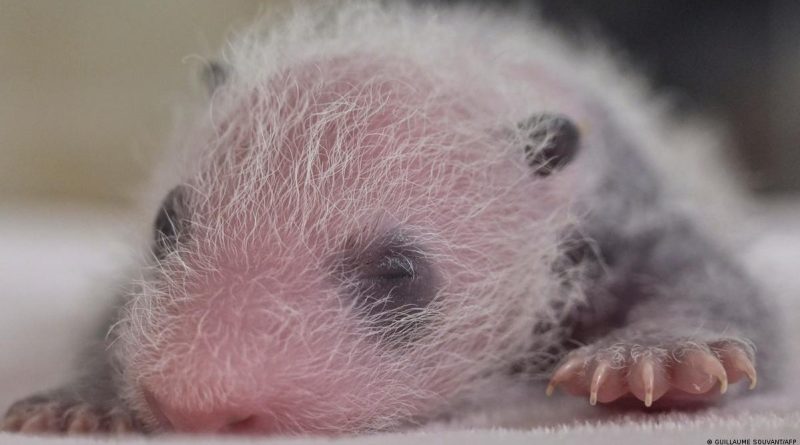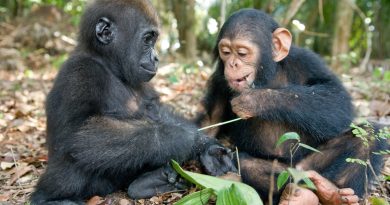Giant Panda cubs are born surprisingly small, but it turns out that’s because they’re “undercooked”
When they are born, giant pandas are not big. In fact, they are so small compared to their moms that it’s almost funny. Now, new research on baby panda skeletons has shown that when panda cubs are born, they are at a stage of development that would be considered premature in almost every other mammal.
In short, giant pandas are born at what we would call the beginning of the third trimester if they were human babies.
Newborn pandas are about the same size as a cat’s kittens, at 90 to 130 grams (3.2 to 4.6 ounces). This is not at all what you’d expect from a bear that weighs 120 kilograms (220 pounds).
Biologists have never been able to figure out how much a giant panda (Ailuropoda melanoleuca) weighs at birth. The bears are born pink, squeaking, and blind, still looking like a fetus. They are also very small compared to their mothers, with a mass ratio of about 1:900. Most mammals have a birth weight ratio closer to 1:26, so this is the lowest of all placental mammals.
In fact, all bears in the family Ursidae have unusually small cubs, but this is especially true of giant pandas. This usually only happens in monotremes and marsupials, which have babies that are so small they could fit in the palm of their hand. The mother then feeds the baby very well, usually in a pouch, until the baby is done baking.
But bears like pandas do not have pouches. So Peishu Li and Kathleen Smith, both biologists at Duke University, decided to look at the bones of giant panda cubs to find out why.
It has been hard to figure out how to breed the ecologically vulnerable giant panda in captivity, and any cubs born from these programs are given the best care possible, so it is not easy to get the bones of panda cubs.
But in the 1980s, Ling-Ling and Hsing-Hsing had five cubs at the Smithsonian’s National Zoo. Unfortunately, none of the cubs lived long after they were born. Their skeletons were still in good shape, so Li and Smith could use micro-CT scans to look at two of them.
They also scanned the newborns of grizzly bears (Ursus arctos), sloth bears (Melursus ursinus), polar bears (U. maritimus), a red panda (Ailurus fulgens), a coati (Nasua narica), an African wild dog (Lycaon pictus), an arctic fox (Vulpes lagopus), and two domestic
They made 3D models of all the skeletons and carefully looked at them to see how developed they were. They looked at the level of ossification, or bone growth, whether the teeth had started to form or erupt, and whether the plates of the skull had fused together.
One idea about why bear babies are small at birth is that it has to do with hibernation. The idea is that if a bear’s pregnancy happens at the same time as hibernation, the mother’s reserves could run out and the baby would be born sooner.
Scientists have said that over the course of evolution, low birth weight could have become a trait of bears in general. For example, giant pandas don’t hibernate.
But in this study, when the biologists looked at all the skeletons and compared them, they found that the skeletons of newborn bears were, on average, just as developed as the skeletons of newborn animals of other species. This would mean that bear cubs are born when they are fully grown.
Except for one thing. The cubs of the giant panda. Their bones looked like those of a puppy that was born a few weeks early, when it was about 70 percent of the way through its pregnancy.
Smith said, “That would be like a 28-week-old baby.” (A human baby is made in 40 weeks.)
When you think about how small the cubs are, 97 to 161 days seems like a long time for a giant panda to be pregnant. Studies have shown that this is because of a process called delayed implantation, in which the embryo floats around in the uterus for a few months before attaching to the wall of the uterus. Only after this attachment does the embryo start to grow and develop.
This is a common thing for bears to do, and it might have something to do with how much food is around. But for pandas, the time it takes to get pregnant after mating is much shorter than it is for other bears. They go through the same stages of development as other mammals, but they come out before they are finished.
Li said, “They’re mostly undercooked.”
What’s the reason? We still don’t know, though. We do know that over the last 20 million years, adult bears have grown bigger. It’s possible that while the bears grew, the weight of their cubs did not.
“Given its close phylogenetic affinity with other ursine bears and adaptations to a herbivorous diet like the giant panda, the cave bear may be a promising candidate to shed more light on the relationship between phylogeny, herbivory, and reproductive physiology among Ursidae,” the researchers write in their paper.



